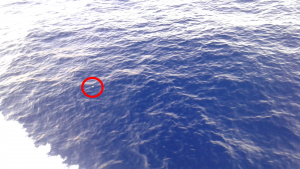by Anastasia Yanchilina, Weizmann Institute of Science
While taking break from shift and expecting to see nothing but water and maybe some clouds in either direction, I could not help but notice plastic trash littering the ocean. Where did all this garbage come from?

A piece of plastic seen off the side of the ship, the inspiration for this post. Photo by Anastasia Yanchilina.
We are currently working our way through the North Pacific Gyre, a region of the ocean known as the “Horse latitudes”. This area is characterized by calmer winds which could trap ships in the pioneer days of sailing and maritime voyaging for days or even weeks. The name “Horse latitudes” potentially originates from Spanish sailors who had to ditch their horses overboard during transit because of water shortages after their ship became becalmed in the middle of the ocean.
Today, instead of trapping ships, the gyre traps plastic, where it is fast becoming a potential hazard to sea life and navigation. A gyre is a region of the ocean where currents move in a circular formation. This water can draw objects inward. When garbage works its way into the gyre, it can easily get trapped. This is because the rotational currents surrounding the garbage keep it from working its way out.
Plastic trash is sourced from the overuse and improper disposal of plastics. Over time, debris captured in currents makes its way into the North Pacific Gyre and begins to accumulate. Plastics are not biodegradable, and only a portion of these plastics will begin the very slow process of degradation into the smaller pieces called “microplastics.”
The area in the North Pacific where plastic has been accumulating was named the Great Pacific Garbage Patch. This area is defined by high concentrations of plastic particles and other debris. The exact size of the patch is unknown since many of the particles are too small to see and are suspended at or just below the surface. Some estimates show a geographic coverage twice the size of France. It was first discovered in the late 1990’s by a racing boat Captain Charles Moore who was sailing between Hawaii to California, a route not too different than the one we are taking on the R/V Sikuliaq.
This discovery led Capt. Moore on the quest to quantify the amount of plastic in the North Pacific Gyre. Researchers have collected ~750,000 bits of microplastic in just 1 km2 of the patch. This problem is not limited to the open ocean, the amount of microplastic in coastal waters has also increased since this is one place where the trash may originate.
In addition, similar patches also exist in the Western Pacific Gyre, Atlantic, and Indian Oceans created under similar ocean current conditions.
The plastic is not just unappealing to the eye but may cause insurmountable harm to marine mammals and turtles that mistake the plastic for some of their favorite food. Ingesting plastic can cause ruptured organs and introduces plastics into the food chain. Large marine mammals like whales that consume large volumes of water to filter out plankton may unknowingly be consuming many microplastics as well. However, marine mammals aren’t the only ones affected. Microplastics can be ingested by small marine organisms at the bottom of the food chain. This may eventually affect organisms higher up on the food chain and may even make it to the local dinner table.
Ships like the R/V Sikuliaq take certain precautions to ensure we do not contribute to the plastic problem. There are many national and international maritime laws that dictate waste management, air quality management and oil pollution protocols to protect the marine environment, air and water.
Finding a permanent solution to the plastic problem may take some time. However, we can begin to alleviate this problem by recycling, using more biodegradable products, and being conscious of daily garbage disposal.
